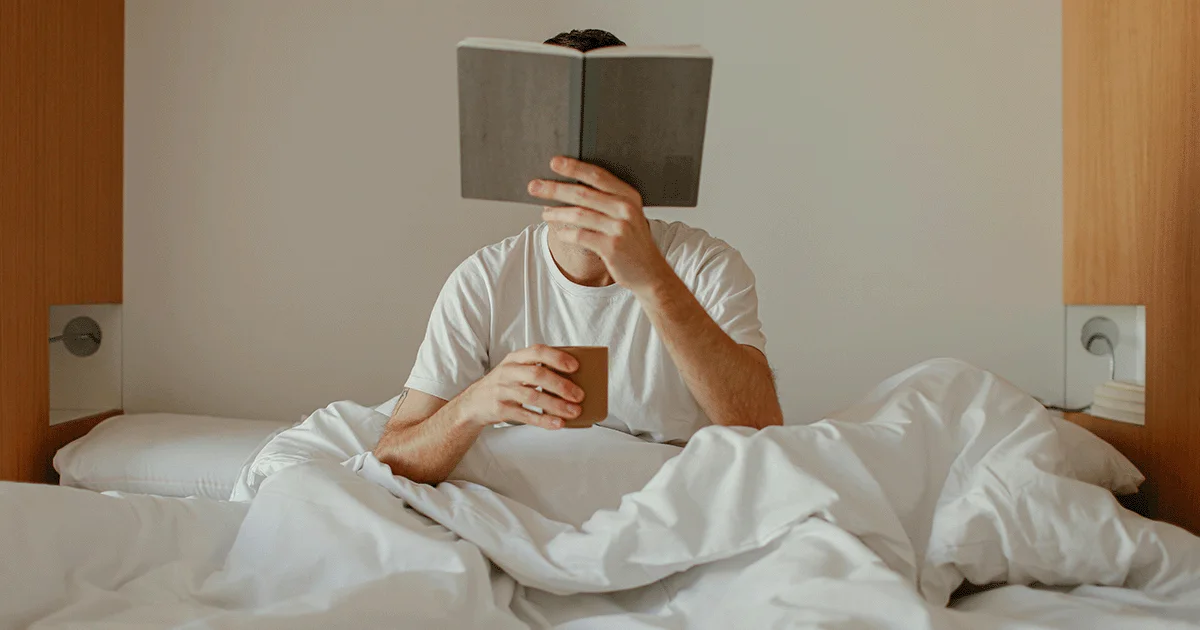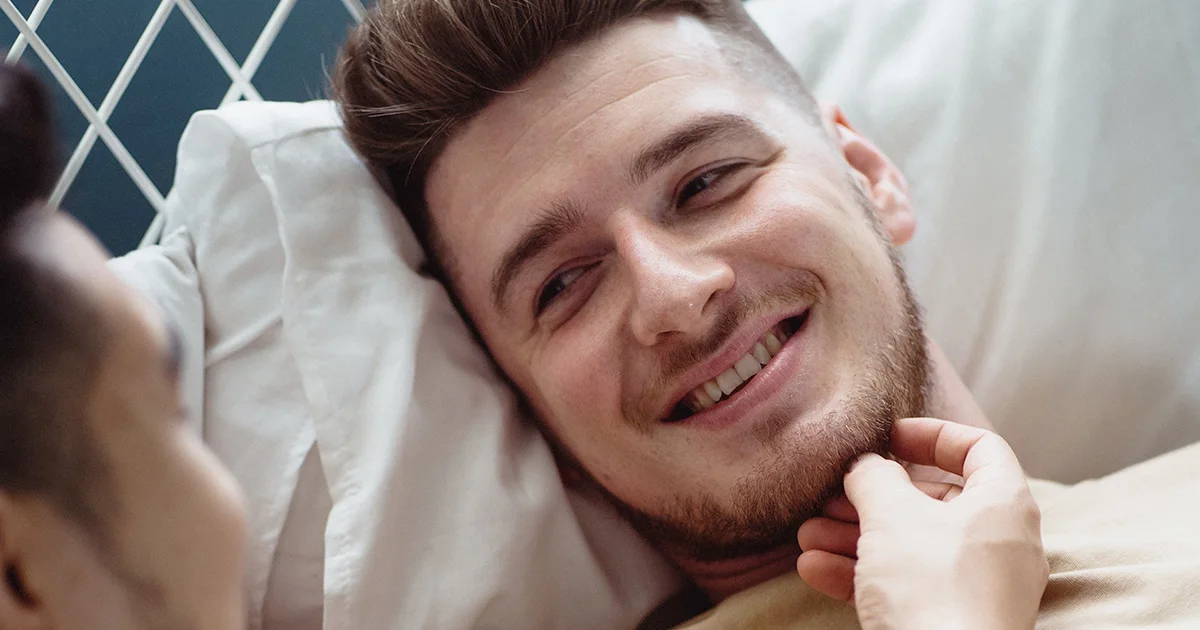Here's what we'll cover
Here's what we'll cover
Pornography is a healthy part of many people’s sex lives—both men and women—and it can be something couples enjoy together or individually. However, consuming too much porn can create unrealistic ideas about sex. If these ideas create disappointment with real-life sexual encounters, a person’s arousal levels can drop and interfere with their ability to have an erection. Let’s explore porn-induced erectile dysfunction in-depth and some ways to manage it.
What is porn-induced ED?
It might seem counterintuitive that something like porn—which spices up many people’s sex lives—could be associated with lower sexual satisfaction. But, some researchers think watching too much of it could lead to erectile dysfunction (ED), which is when a man has trouble getting or keeping an erection firm enough for sex. Other kinds of sexual dysfunction can also arise, including delayed ejaculation, decreased interest in sex, and reduced sexual satisfaction (Park, 2016).
Can porn cause erectile dysfunction?
The short answer: possibly, according to some researchers.
In recent years, there’s been an unexplained rise in sexual dysfunction in men under 40, including erectile dysfunction, delayed ejaculation, low libido, and reduced sexual satisfaction (Park, 2016). Of course, any time something is “unexplained,” you’ll find many people trying to find an explanation. Many possibilities are being explored, and one theory focuses on the role excessive use of porn might play. Since rates of ED and internet porn consumption have risen at the same time, and given that ED can have psychogenic (psychologically-induced) causes, a link between the two is possible (Berger, 2019).
The increase in ED rates in younger men is clear. In 1999, a large study indicated that only 5% of men below the age of 59 experienced sexual dysfunction; another study in 2002 found that this number was closer to 2% in men under 40 (Laumann, 1999; Prins, 2002). Yet, just a decade later, these numbers had begun to skyrocket. In 2011 a study found the rate of ED among European men below the age of 40 was as high as 28% (Landripet, 2015). In 2014, a Canadian study found sexual dysfunction in over 50% of men aged 16–21 (O’Sullivan, 2014).
Clearly, something had been occurring worldwide that was causing higher rates of sexual dysfunction in otherwise healthy men. (Remember, ED is often the sign of an underlying health condition, like cardiovascular disease, obesity, diabetes, mental health issues, and others). Increased rates of obesity are one possibility, as are drug use, depression, and anxiety. Yet many researchers don’t feel that these lifestyle and health-related causes can fully explain the rise in ED in young men.
Enter: porn-induced erectile dysfunction. At roughly the same time that younger men’s sexual function seems to have declined, the age of mass internet access began, and free, instantaneous porn became available to people worldwide. Thanks to cell phones, headphones, and free porn websites, porn-watching is available anonymously and at any time to anyone. Indeed, in the U.S. alone, up to 74% of men and 46% of women are estimated to use pornography (Berger, 2019).
The need to look at porn use and ED in context
But can we really blame porn for erection problems? Many researchers find the evidence compelling that there’s an association in young men between viewing pornography and experiencing sexual dysfunction across the world. But other researchers are less convinced. They suggest that, while there is strong evidence for an association between porn-watching and decreased sexual satisfaction, there isn’t enough evidence to support a causal relationship between the two (Dwulit, 2019; Landripet, 2015).
We need to consider porn-watching in context. An individual’s relationship status, healthy communication with their partner(s), attitudes towards porn, and frequency of use could each positively or negatively impact their sexuality.
Some couples watch porn together or with one another’s knowledge and consent, and find that it enhances their sex life (Dwulit, 2019). Other people might feel shame about using porn or may use it compulsively or in secret, which could lead to sexual dysfunction.
One study indicated that porn-related sexual dysfunction was most pronounced among men with stronger ties to religion, suggesting that the attendant moral shame of watching porn can play a strong role in it causing ED (Perry, 2019). Another study found a link between ED and people who say they have a problem with porn⸺but there wasn’t a consistent association between ED and general, non-problematic use of porn (Grubbs, 2019).
These widely varying contexts of porn-watching show us that it may be hard for researchers to make clear-cut statements about when and how much porn consumption will cause ED. Let’s explore some of the ways that porn can contribute to sexual dysfunction to see how these different contexts may apply to individuals.
How does porn cause ED?
They may seem simple, but erections require the complex cooperation of many bodily and mental processes. Your hormones, nerves, blood circulation, and mood all work together to help you get and keep an erection. ED occurs when one or more of these functions stops working. Watching porn can impact this in a few ways.
Psychological causes of porn-induced ED
Mental health issues, like depression, low self-esteem, and performance anxiety, are common causes of ED. The effect of porn on your expectations of sex, yourself, or your partner can have the same effect. Here’s how.
Changes in the brain’s arousal circuitry
Pornography has been around for millennia, but consider the impact the internet has had: limitless novelty, easy escalation to hardcore content, and instant access to new scenes. Frequent stimulation by this kind of porn has been shown to coincide with altering the way your brain experiences pleasure and reward. The brain’s natural neural response to sexual stimuli is decreased, requiring more frequent and extreme stimuli to achieve the same level of sexual arousal. Real-world sexual stimulation may no longer be enough for your brain—and penis—to feel aroused (Kühn, 2014).
More research is still needed (for example, were people who watch excessive porn already predisposed to needing extra stimuli to get aroused?), but there is compelling logic to this argument; frequent exposure to anything can desensitize a person to it so that more is required to create the same response (Kuhn, 2014).
However, these kinds of changes don’t tend to be permanent. Like any mental health issue, there are various resources to help you shift your sexual focus and reduce excessive dependence on porn.
Unrealistic expectations
Pornography frequently features dramatized, extreme performances by hyper-sexualized actors. If a person’s primary sexual exposure is to this kind of imagery, it can cause them to form unrealistic expectations of their partners or of sex itself. Real-life sex generally involves average human individuals and requires a certain tolerance to and sense of humor about awkward, funny moments. If this reality isn’t part of a person’s expectations for sex, the result can be that they don’t feel as aroused—a key component of keeping an erection (Park, 2016).
Performance anxiety
Male actors in pornography frequently have bodies, penises, or attitudes that (fortunately) aren’t matched by the average man. However, setting expectations of sexual performance for yourself based on male porn actors can give you—especially if you’re a young man—the belief that you need to look and act in the same way in order to be a good lover (Park, 2016). Stress of any kind can make it difficult to have an erection, but performance anxiety can make it especially stressful and difficult, even though your sexual partners probably don’t have these same expectations of you.
Physical causes of porn-induced ED
It is normal for sex and masturbation (with or without porn) to diminish a man’s ability to have another erection for a certain period after orgasming. This is called a refractory period (Valente, 2021). If a man, through compulsive behavior, is frequently masturbating to pornography, then he will have more refractory periods and thus greater difficulty in maintaining an erection during sex if it follows shortly after.
How to manage porn-induced ED
Since ED is often a sign of a bigger underlying medical problem, it’s very important to talk to your healthcare provider about any sexual problem you experience. But once you rule out other medical causes, and if you think watching porn could be a factor, there are a few steps you can explore to help solve the issue:
Communicate
Start by asking yourself some thoughtful questions to help understand what you’re experiencing, what the causes might be, and what may be some helpful tools for fixing it:
What kind of sexual problems am I experiencing? Am I having problems with my erection, ejaculation time, sexual satisfaction, or arousal?
Could there be a medical cause for my issues? What does my healthcare provider think?
How frequently do I watch porn? What kinds of porn am I watching, and has there been a shift in what kind of porn I need to become aroused?
Do I find myself mentally and emotionally aroused when I’m in a real sexual situation?
What are my expectations of myself and my partner?
What are my moral attitudes towards porn? Am I ashamed or embarrassed to be watching it?
Erectile dysfunction can be difficult for both you and your partner, so it is important to have honest and safe conversations where you can both communicate openly.
Take a break from porn
Porn is a normal, healthy part of many people’s sexuality. However, if you are experiencing ED, have established that it isn’t due to other causes, and think that it may be related to your exposure to porn, try taking a break and learn to masturbate without it. This doesn’t mean that you can never watch porn again, but taking some time to allow your body and brain to reset themselves can help make things clearer. You may find that your erections improve during sex. You can also take the time to read books about sex and arousal and to explore your sensuality and sexuality in new ways.
Consider counseling
Talk therapy is a valuable tool for people experiencing ED from any cause, not just due to porn consumption. Speaking with a mental health professional can help you to understand and balance your relationship with porn, address any problematic beliefs or behaviors around relationships and sex, and develop the ability to own your sexuality in ways that are supported by—not directed by—pornography.
Enjoyment of porn and masturbation can be healthy and positive parts of you and your partner’s sexual experiences. While there is compelling evidence that (like anything in life), too much can be a problem for your sexual health, there are many simple ways that you can address this with yourself, your partner, and your healthcare provider.
If you’re experiencing ED and think it could be related to your use of porn, start by talking to your provider and work on exploring other ways to enjoy your sexuality. At the very least, it can help you be more confident and build better relationships with your partners—which can help erectile function and improve your sex life.
DISCLAIMER
If you have any medical questions or concerns, please talk to your healthcare provider. The articles on Health Guide are underpinned by peer-reviewed research and information drawn from medical societies and governmental agencies. However, they are not a substitute for professional medical advice, diagnosis, or treatment.
Berger, J.H., Kehoe, J.E., Doan, A.P., Crain, D.S., Klam, W.P., Marshall, M.T., et al. (2019). Survey of sexual function and pornography. Military Medicine, 184 (11-12), 731–737. doi: 10.1093/milmed/usz079. Retrieved from https://academic.oup.com/milmed/article/184/11-12/731/5477443
Dwulit, A. D. & Rzymski, P. (2019). The potential associations of pornography use with sexual dysfunctions: an integrative literature review of observational studies. Journal of Clinical Medicine, 8 (7), 914. doi: 10.3390/jcm8070914. Retrieved from https://www.ncbi.nlm.nih.gov/pmc/articles/PMC6679165/
Grubbs, J.B. & Gola, M. (2019). Is pornography use related to erectile functioning? Results from cross-sectional and latent growth curve analyses. Journal of Sexual Medicine, 16 (1):111-125. doi: 10.1016/j.jsxm.2018.11.004. Retrieved from https://pubmed.ncbi.nlm.nih.gov/30621919/
Kühn, S. & Gallinat, J. (2014). Brain structure and functional connectivity associated with pornography consumption: the brain on porn. Journal of the American Medical Association Psychiatry, 71 (7):827–834. doi: 10.1001/jamapsychiatry.2014.93. Retrieved from https://jamanetwork.com/journals/jamapsychiatry/fullarticle/1874574
Landripet, I. & Štulhofer, A. (2015). Is pornography use associated with sexual difficulties and dysfunctions among younger heterosexual men? Journal of Sexual Medicine,12 (5):1136-9. doi: 10.1111/jsm.12853. Retrieved from https://pubmed.ncbi.nlm.nih.gov/25816904/
Laumann, E.O., Paik, A., & Rosen, R.C. (1999). Sexual dysfunction in the United States: prevalence and predictors. Journal of the American Medical Association, 281 (6):537-44. doi: 10.1001/jama.281.6.537. Retrieved from https://jamanetwork.com/journals/jama/fullarticle/188762
O'Sullivan, L.F., Brotto, L.A., Byers, E.S., Majerovich, J.A., & Wuest, J.A. (2014). Prevalence and characteristics of sexual functioning among sexually experienced middle to late adolescents. Journal of Sexual Medicine, 11 (3):630-41. doi: 10.1111/jsm.12419. Retrieved from https://med-fom-brotto.sites.olt.ubc.ca/files/2014/12/OSullivan-et-al.-2014-Prevalence-and-characteristics-of-sexual-functioning-among-sexually-experienced-middle-to-late-adolescents-3554-1.pdf
Park, B. Y., Wilson, G., Berger, J., Christman, M., Reina, B., Bishop, F., et al. (2016). Is internet pornography causing sexual dysfunctions? A review with clinical reports. Behavioral Sciences (Basel, Switzerland), 6 (3), 17. doi: 10.3390/bs6030017. Retrieved from https://www.ncbi.nlm.nih.gov/pmc/articles/PMC5039517/
Perry, S.L. & Whitehead, A.L. (2019). Only bad for believers? religion, pornography use, and sexual satisfaction among American men. Journal of Sexual Research, 56 (1):50-61. doi: 10.1080/00224499.2017.1423017. Retrieved from https://pubmed.ncbi.nlm.nih.gov/29377724/
Prins, J., Blanker, M.H., Bohnen, A.M., Thomas, S., & Bosch, J.L. (2002). Prevalence of erectile dysfunction: a systematic review of population-based studies. International Journal of Impotence Research, 14 (6):422-32. doi: 10.1038/sj.ijir.3900905. Retrieved from https://www.nature.com/articles/3900905
Valente, S., Marques, T. & Lima, S.Q. (2021). No evidence for prolactin’s involvement in the post-ejaculatory refractory period. Communications Biology, 4 (10). doi: 10.1038/s42003-020-01570-4. Retrieved from https://www.nature.com/articles/s42003-020-01570-4#citeas












